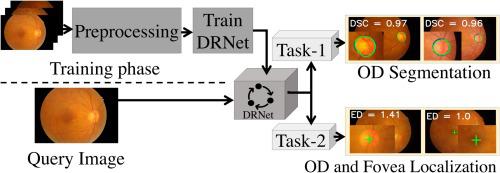Artificial Intelligence in Medicine ( IF 6.1 ) Pub Date : 2020-12-13 , DOI: 10.1016/j.artmed.2020.102001 Md Kamrul Hasan 1 , Md Ashraful Alam 1 , Md Toufick E Elahi 1 , Shidhartho Roy 1 , Robert Martí 2

|
Background and objective
In modern ophthalmology, automated Computer-aided Screening Tools (CSTs) are crucial non-intrusive diagnosis methods, where an accurate segmentation of Optic Disc (OD) and localization of OD and Fovea centers are substantial integral parts. However, designing such an automated tool remains challenging due to small dataset sizes, inconsistency in spatial, texture, and shape information of the OD and Fovea, and the presence of different artifacts.
Methods
This article proposes an end-to-end encoder-decoder network, named DRNet, for the segmentation and localization of OD and Fovea centers. In our DRNet, we propose a skip connection, named residual skip connection, for compensating the spatial information lost due to pooling in the encoder. Unlike the earlier skip connection in the UNet, the proposed skip connection does not directly concatenate low-level feature maps from the encoder's beginning layers with the corresponding same scale decoder. We validate DRNet using different publicly available datasets, such as IDRiD, RIMONE, DRISHTI-GS, and DRIVE for OD segmentation; IDRiD and HRF for OD center localization; and IDRiD for Fovea center localization.
Results
The proposed DRNet, for OD segmentation, achieves mean Intersection over Union (mIoU) of 0.845, 0.901, 0.933, and 0.920 for IDRiD, RIMONE, DRISHTI-GS, and DRIVE, respectively. Our OD segmentation result, in terms of mIoU, outperforms the state-of-the-art results for IDRiD and DRIVE datasets, whereas it outperforms state-of-the-art results concerning mean sensitivity for RIMONE and DRISHTI-GS datasets. The DRNet localizes the OD center with mean Euclidean Distance (mED) of 20.23 and 13.34 pixels, respectively, for IDRiD and HRF datasets; it outperforms the state-of-the-art by 4.62 pixels for IDRiD dataset. The DRNet also successfully localizes the Fovea center with mED of 41.87 pixels for the IDRiD dataset, outperforming the state-of-the-art by 1.59 pixels for the same dataset.
Conclusion
As the proposed DRNet exhibits excellent performance even with limited training data and without intermediate intervention, it can be employed to design a better-CST system to screen retinal images. Our source codes, trained models, and ground-truth heatmaps for OD and Fovea center localization will be made publicly available upon publication at GitHub.1
中文翻译:

DRNet:从糖尿病视网膜病变图像中分割和定位视盘和中央凹
背景和目的
在现代眼科中,自动计算机辅助筛选工具 (CST) 是至关重要的非侵入式诊断方法,其中视盘 (OD) 的准确分割以及 OD 和中央凹中心的定位是必不可少的组成部分。然而,由于数据集较小,OD 和 Fovea 的空间、纹理和形状信息不一致,以及存在不同的伪影,设计这种自动化工具仍然具有挑战性。
方法
本文提出了一种名为 DRNet 的端到端编码器-解码器网络,用于 OD 和 Fovea 中心的分割和定位。在我们的 DRNet 中,我们提出了一种跳跃连接,称为残差跳跃连接,用于补偿由于编码器中的池化而丢失的空间信息。与 UNet 中较早的跳过连接不同,所提出的跳过连接不直接将来自编码器起始层的低级特征图与相应的相同尺度解码器连接起来。我们使用不同的公开可用数据集验证 DRNet,例如用于 OD 分割的 IDRiD、RIMONE、DRISHTI-GS 和 DRIVE;IDRiD和HRF用于OD中心定位;和 IDRiD 用于中央凹中心定位。
结果
提议的 DRNet 用于 OD 分割,对于 IDRiD、RIMONE、DRISHTI-GS 和 DRIVE,分别实现了 0.845、0.901、0.933 和 0.920 的平均交集(mIoU)。就 mIoU 而言,我们的 OD 分割结果优于 IDRiD 和 DRIVE 数据集的最新结果,而它在 RIMONE 和 DRISHTI-GS 数据集的平均灵敏度方面优于最新结果。对于 IDRiD 和 HRF 数据集,DRNet 以平均欧氏距离 (mED) 分别为 20.23 和 13.34 像素来定位 OD 中心;它比 IDRiD 数据集的最新技术高 4.62 个像素。对于 IDRiD 数据集,DRNet 还成功地定位了中央凹中心,mED 为 41.87 像素,比同一数据集的最新技术高 1.59 像素。
结论
由于所提出的 DRNet 即使在训练数据有限且没有中间干预的情况下也表现出出色的性能,因此可用于设计更好的 CST 系统来筛选视网膜图像。我们用于 OD 和 Fovea 中心定位的源代码、训练模型和地面实况热图将在 GitHub 上公开发布。1











































 京公网安备 11010802027423号
京公网安备 11010802027423号